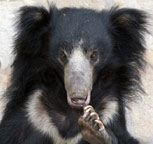
* BearLife.org * Polar Bears * Panda Bear * Koala * Grizzly Bear * Black Bear * Red Panda *
* Brown Bear * Kodiak Bear * Sun Bear * Kermode Bear * Sloth Bear * Moon Bear * Spectacled Bear * Bear Cruelty *
Sloth Bear

- The sloth bear has thick shaggy fur that is black to brown colored. Its ears are lined with long fur and it has a long snout, a long tongue, round eyes, and a large nose. Its head resembles a domesticated dog. The area around it’s muzzle and eyes are cream colored. The sloth bear has a distinct V or U-shaped pattern displayed on its chest that is white or gold colored.
- At one time this curious species was classified as a sloth. It does have long claws, it is an excellent tree climber, and it moves slow. However it is definitely a member of the bear family Ursidae. It’s classification is Melursus Ursinus.
-
Common habitats include grasslands, forests, and dense brush lands. They are found in India, Bangladesh, Sri Lanka, Bhutan, and Nepal.
-
Their favorite food is termites, other insects, and grubs. In their habitat these are abundant and available all year long. They will also eat leafy plants, fruits, nuts, root vegetables, honey, and rodents.
-
Specialized adaptations help them find their food. They have a long muzzle and nostrils that can close at will. Combined with their long tongue and lips they can penetrate termite holes and operate like a powerful vacuum cleaner to suck up the tasty insects. They also has long curved claws. They use their claws to detach and uncover vegetation to locate insects and prey. Their claws are larger than most bear species. Long claws are especially useful when looking for insects. They aid in prying off bark, penetrating termite and bee nests, and turning over logs and stones.
-
Males weigh around 225 to 300 pounds. Females are about 125 to 200 pounds and are 4 to 5 feet long. Height is 3 to 4 feet high, length is 5 to 6 feet long.
-
Sloth bears do not hibernate due to their warmer climates and the availability of food sources throughout the year.
-
Life span is estimated to be 20 to 30 years in the wild. Precise figures are unknown. Estimates are partially based on those in captivity, which can live to be up to 35 to 40 years old. In the wild many sloth bears succumb to survival hardships and conflicts with mankind.
-
Breeding season is dependent on region. In most areas mating takes place during the summer and cubs are born in the spring. However in some areas such as Sri Lanka, mating can take place most of the spring and summer, if not all year.
-
Litter size is usually 1 to 3. Although there have been rare sightings of up to four cubs being nurtured by a single mother, this is extremely uncommon and an extra challenge for her.
-
Cubs stay with their mother for 2 to 3 years and like to hitch a ride on her back.
-
Sloth bears like to escape from the heat of the day and forage for food at night. They will start to become active as the sun starts to set. This is also the time when many insects such as termites are more active. The sloth bear will use its excellent sense of smell to locate food. It will return to well known feeding areas and work its way around to find insects, fruits, and other favorite foods. Often a fresh supply of bugs will replenish the ones that were sucked up during a previous raid. The sloth bear will return the next day or so to check for “second helpings”.
-
Exact population figures are not available but it is estimated there is somewhere between 8000 to 10000 bears living in the wild.
-
Threats against the sloth bear include loss of habitat, destroyed termite and ant nests due to various development projects, widespread poaching, and persecution from crop farmers.
-
Sloth bear cubs are often snatched from the wild and become unwilling victims as dancing bears.
Bears * About Us * Contact Us * Bear Cruelty
